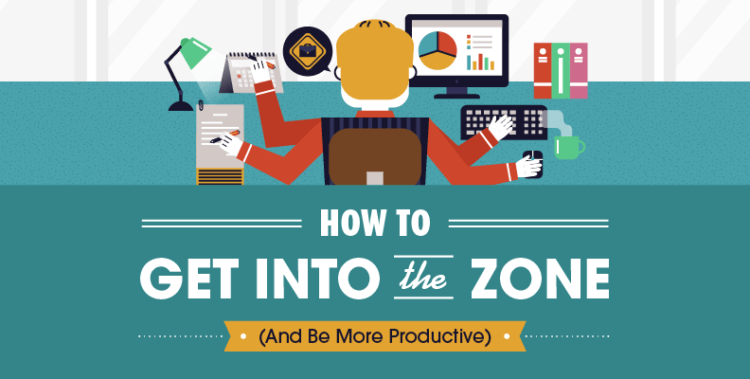Sometimes it may be that you start showing signs of procrastination because there is no real blood rush behind certain actions or you are not directly inspired or motivated by a particular type of activities. Recognizable for most of us in the form of ‘homework evasive behavior’ that we all know from high school. The crux is that your brain sometimes just does not get warmed up enough or goes into the rhythm to become productive. And then those cat movies and internet fun compilations – I dare you to click – are suddenly much more interesting than doing something productive …
Sounds familiar? Fortunately, there are ways to warm up your brain and get into a rhythm where you not only become more productive but also look smarter at activities that you might find annoying to do. Ways that help you to see from different perspectives and prevent rut. Read these tips to get your brain into a productive rhythm and find out how you get into a flow faster and double your productivity.
1. Zoom out
What were those bigger goals that you wanted to achieve? In what way do the activities that you have to carry out contribute to this? Do not they contribute in any way? Stop it!
2. Check your preconditions
Why do you let yourself be distracted or can you only think of opening a bag of chips and checking your WhatAspp? Consider the environment you are in and which factors affect your behavior. Is it (too) hot or (too) cold? Is there unrest or movement in your field of vision? Is there music that does not contribute to your concentration? Do you have things on your mind that makes it difficult to focus on what you have to do? In a large number of cases, you can do something about the factors that take you away from your concentration. Put quiet music on for example. Air your workspace. 20 minutes of running and then taking a shower. The optimal preconditions that apply to you do not have to be the same preconditions for another person. But by becoming aware of what helps you to get into a rhythm and flow you take a big step towards a more productive life.
3. Avoid analysis paralysis
Indeed, for the more analytically oriented people, this is probably a recognizable one. If you are used to working with data, statistics and/or reports, you can quickly lose yourself in analyzing this. There is, of course, nothing wrong with carrying out targeted analyzes when it serves your goals; it is a different story when you catch yourself staring at Google Analytics for 2 hours to find out that the only visitor on your website is yourself.
4. Do something creative
When you are hitting something, it means that you are not in a flow. By doing something creative, you break this pattern. What should you do? I can not tell you that, but you too well. One person likes to write. The other one likes sketching or designing a concept in Photoshop. Someone else is pleased with music, video or audio. Create something in a form that you like and let your creative juices flow.
5. Connect procrastination with the creation
The trick then is not only to ‘be creative,’ but also to connect the creation with the larger goal (see 1) that you finally have in mind to connect with the work that has to be done. For example, writing this blog helps me to get my bear in a productive rhythm. Writing the blog is the creation for me. The subject is the connection to what I want at this moment (being more productive!). The joke is that, while I write this, I notice that I’m in a mode to be productive. The report that I have to draw up and put all in front of me all morning ensures that I can achieve my bigger goals (grow as a person, as an entrepreneur and help clients to grow). And because my fingers now fly over the keyboard and my brain makes these connections, I want to get things done because I know that now – in this momentum – I can do them better, faster and smarter than an hour ago.
6. Test the potential of the ‘boring’ work
If you perform Action A, what kind of favorable outcomes B, C, and D can do for you? Can it create opportunities? Can it lead to new insights? Does it ensure that you guarantee the financial peace to continue working on your bigger goals and dreams? Usually, you can reduce some motivational elements. And if you do not succeed, make sure that you no longer have to carry out the actions yourself.
7. Decide which things you can spend (and take immediate action to do so)
The moment you are aware that you are doing things that you do not get energy from, ask yourself the question “can I outsource this?” Remember that those hours you spend on tasks that you are tired of (even though you see the added value for yourself) you do not only have to spend those hours spent. It costs you at least double the productivity because your energy level drops and your brain starts to work at a sub-optimal frequency.
If someone can perform specific tasks faster and better than you, you will have the peace and space to focus on those things that have the most impact on your bigger goals. And the conscious choice for this alone makes space in your head clear. Then do not forget to convert this choice into action immediately. Identify tasks and sub-tasks that you can transfer and then transfer them immediately. That clears up nicely in your action list.


Pingback:How Clear Goals Impact Achievements | Lorelei Web